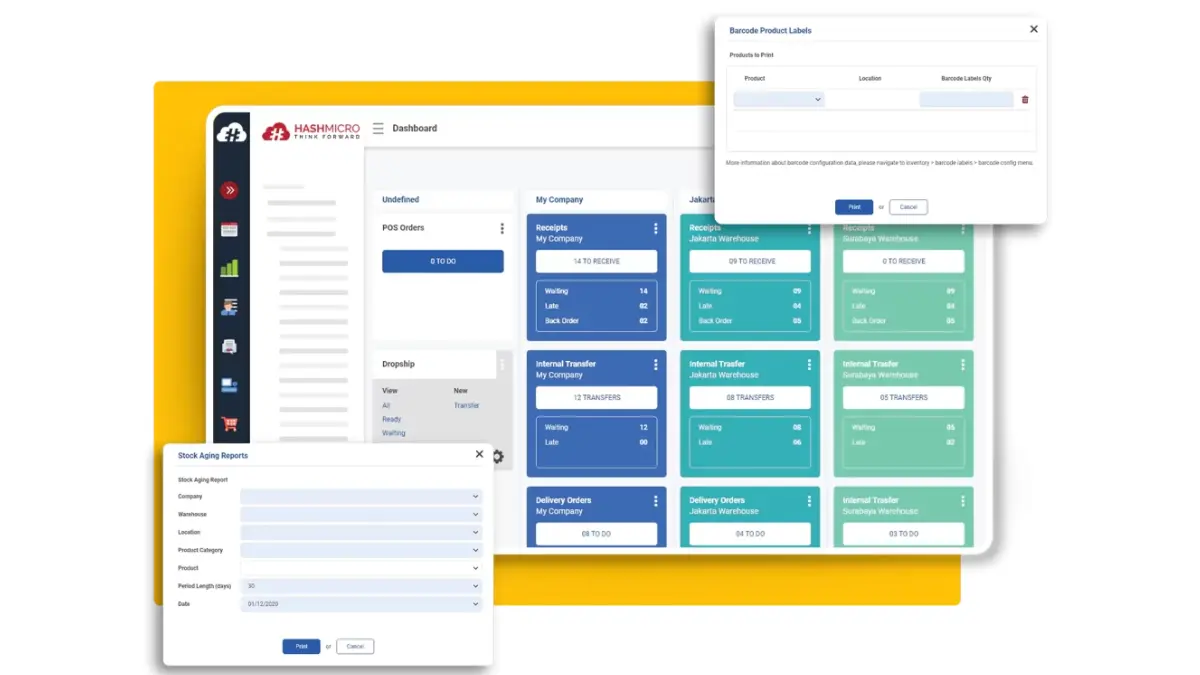Your mabentang produkto runs out of stock unexpectedly, and sales start slipping away while customers grow frustrated. At the same time, you’ve overstocked items that aren’t selling, leaving your money tied up in unsold goods. Without a proper system to track inventory, these issues quickly cut into your profits.
A periodic inventory system can prevent these headaches. By helping you stay on top of your stock with minimal hassle, it ensures you’re never caught off guard. Want to know how this system can keep your business running smoothly? Let’s dive in!
Key Takeaways
|
Table of Contents

What is a Periodic Inventory System?

The periodic inventory system is a straightforward method used to record inventory data at specific intervals, typically at the end of a reporting period. Instead of continuously updating stock levels, businesses using this system conduct physical counts at regular intervals, such as monthly, quarterly, or annually.
These counts are then used to calculate the cost of goods sold (COGS) and update the inventory reports. What sets the periodic inventory system apart from other methods, such as the perpetual inventory system, is its simplicity and low cost.
Unlike perpetual systems that rely on advanced technology to track inventory in real-time, the periodic system focuses on stock assessments periodically. This makes it an attractive option for small businesses and operations with lower sales volumes.
How This System Works
The periodic inventory system tracks stock at set intervals, typically monthly or yearly. During these intervals, businesses conduct physical counts, often referred to as cycle counts, to assess inventory levels. After the count, the cost of goods sold (COGS) is calculated by subtracting the ending inventory from the total of the opening inventory and purchases.
- Record the opening inventory at the beginning of the period.
- Add purchases made throughout the period.
- Perform a physical count at the end of the period.
- Calculate ending inventory and COGS.
This method offers a simple approach to inventory management, allowing businesses to streamline their stock-taking process without the need for expensive systems. Furthermore, this system reduces operational costs, making it an ideal solution for companies that prioritize simplicity and cost efficiency.
Periodic Inventory vs. Perpetual Inventory
When comparing the periodic and perpetual inventory systems, the main difference lies in how frequently inventory is updated. A perpetual inventory system continuously tracks inventory in real-time, while a periodic system updates inventory only at specific intervals.
Each system has its advantages. The periodic system is simpler and cheaper, making it ideal for businesses with low transaction volumes. However, it lacks the real-time accuracy of a perpetual system to avoid inventory shrinkage, which can better serve larger companies with more complex inventory needs. While perpetual systems provide constant oversight, they come with higher implementation costs, especially for small businesses.
Example of Periodic Inventory
Let’s say you own a small retail shop in Manila, and you implement the periodic inventory system. At the start of January, your inventory is valued at PHP 50,000. Throughout the month, you purchase an additional PHP 20,000 worth of goods to keep up with customer demand.
However, you don’t track sales in real-time; instead, you wait until the end of the month to do a physical count. After completing this count, you discover that your remaining inventory is worth PHP 15,000.
Using the periodic inventory system, the cost of goods sold (COGS) for January is calculated as follows:
![]()
For this example, that would be:
![]()
This means you sold PHP 55,000 worth of goods in January. The simplicity of this calculation allows you to assess your sales performance over the month without the need for complex tracking systems.
However, the trade-off is that you won’t have a clear picture of your inventory until the end of each period, potentially leaving gaps in real-time data, and thus might affect your inventory control.
When to Use a Periodic Inventory System
The periodic inventory system is most suitable for businesses with low transaction volumes or those that don’t require constant oversight of their stock. Small retail businesses, food stalls, and independent boutiques often benefit from this approach because of its simplicity and ease of implementation.
Businesses in industries such as hospitality, arts and crafts, and small-scale manufacturing can also find the periodic inventory system advantageous. These businesses typically deal with smaller inventories and fewer daily transactions, making the periodic approach more manageable.
Benefits of the Periodic Inventory System

One of the primary benefits of the periodic inventory system is its simplicity. By conducting physical counts at specific intervals, businesses can effectively manage their inventory without needing to invest in expensive technology.
Some of the benefits are:
- Cost Savings: Businesses save money by avoiding the need for high-tech inventory management software or ongoing maintenance costs.
- Ease of Implementation: This system is straightforward to set up, allowing small businesses to start managing their stock quickly and with minimal training.
- Flexibility: The system allows businesses to choose when to perform physical counts, offering flexibility in scheduling inventory checks during slower business periods.
- Reduced Data Complexity: Unlike perpetual systems that require constant updates, allowing businesses to focus on other key areas without overwhelming themselves with data.
For low-volume operations, the periodic inventory system also provides a practical way to maintain control over inventory while avoiding the burden of constant tracking. Business owners can dedicate their energy to growth and customer service, knowing their stock levels are managed with ease.
Challenges of the Periodic Inventory System
Despite its simplicity, the periodic inventory system has its challenges. One major drawback is the lack of real-time accuracy. Because inventory is only updated periodically, businesses may experience overstocking or understocking between counts. This can result in lost sales or excess inventory, tying up valuable capital.
Some of the challenges are:
- Lack of Real-Time Data: Inventory levels are only updated periodically, leading to potential stock shortages or surpluses between counts.
- Inaccuracies in Stock Management: Without continuous tracking, businesses may struggle to maintain precise inventory records, leading to discrepancies.
- Time-Consuming Physical Counts: Regular physical inventory counts are required, which can be labor-intensive and disruptive, especially for larger operations.
- Delayed Financial Insights: Since inventory data is only updated at intervals, financial decisions based on inventory levels might be delayed or less accurate.
Another challenge is the need for regular physical counts, which can be both time-consuming and labor-intensive. Businesses must often schedule these counts during off-hours or slower periods to minimize disruptions, making it more difficult for operations during busy times.
Best Practices for Managing Periodic Inventory
To effectively manage a periodic inventory system, it’s essential to establish a regular counting schedule. This helps maintain accuracy and ensures that you always have a clear picture of your stock levels. For example, you can set monthly or quarterly stock counts based on your business needs.
Another best practice is to keep detailed records of purchases and sales. By maintaining accurate and timely records, you reduce the likelihood of discrepancies and ensure smooth operations when it’s time to calculate inventory and COGS.
Manage Periodic Inventory With HashMicro’s Inventory Software

HashMicro’s Inventory Software is designed to support businesses in managing periodic inventory with ease and efficiency. Its comprehensive features are tailored to simplify the inventory process, ensuring that you can maintain accurate stock levels while benefiting from the simplicity and cost-effectiveness of the periodic system.
The features of HashMicro’s Software are:
- Stock Take and Inventory Adjustment Management: Easily conduct physical stock counts at scheduled intervals and adjust inventory records based on the results.
- Stock Forecasting: Plan for future stock requirements by analyzing past trends and forecasted sales, helping you stay ahead.
- Stock Reservations & Reporting: Generate detailed reports on stock levels, ensuring accurate calculations of inventory and Cost of Goods Sold (COGS).
- Multi-Location Stock Management: Track and manage inventory across multiple locations, simplifying the periodic inventory process. This ensures all stock is accounted for during physical counts.
With these features, HashMicro’s software supports businesses in staying on top of their stock without the need for complex, real-time tracking systems.
Conclusion
Managing inventory effectively is crucial for the success of any business, especially when stock levels fluctuate and customer demands change. The periodic inventory system offers a simple and cost-effective solution, particularly for businesses with lower transaction volumes.
To streamline this process even further, HashMicro’s Cloud Inventory Software provides powerful features tailored to help you manage periodic inventory efficiently. From automated stock count reminders to detailed reports, our software ensures that you can focus on growing your business while staying in control of your inventory.
Curious about how our software can transform your inventory management? Try our free demo today and see the difference it can make!
Frequently Asked Questions
-
What is a periodic review inventory system?
A periodic review inventory system tracks stock levels at set intervals, such as monthly or quarterly, through physical counts. This method calculates inventory and cost of goods sold based on periodic assessments rather than continuous updates.
-
What describes a periodic inventory system?
It involves conducting inventory counts at specific intervals to update stock levels and calculate the cost of goods sold. It’s a simple and cost-effective method, ideal for businesses with lower sales volumes.
-
Who uses the periodic inventory system?
Small businesses, independent retailers, and low-volume operations commonly use the periodic inventory system. It’s suited for those looking to manage inventory without the need for real-time tracking or complex software.





































